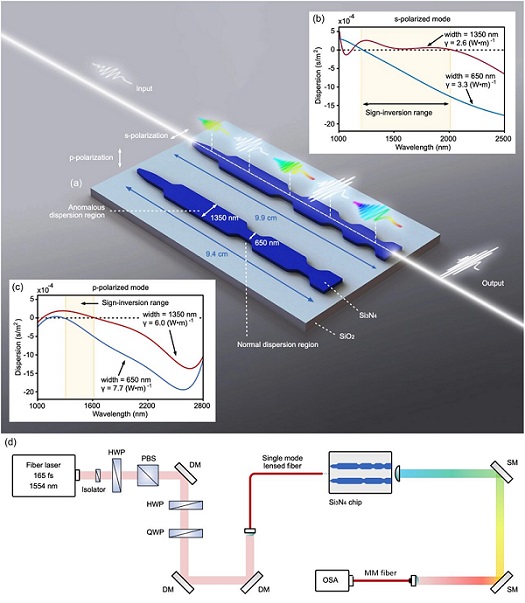An ultra-efficient on-chip supercontinuum laser developed by researchers at the University of Twente is poised to enable applications ranging from portable medical imaging devices to chemical sensing and lidar. The researchers’ design enabled control over the dispersion of light in the laser system by alternately widening and narrowing the beam of light.
Lasers normally emit light that is coherent, meaning that the waves they emit are identical in frequency and waveform. The light’s coherent nature makes it possible to send a narrow beam over extreme distances with very low noise. However, this also means that the laser only emits a single color of light at a time, which limits applications.
Supercontinuum lasers produce a continuous spectrum of color and can therefore appear white. Generating this wide bandwidth of colors has so far required a high peak power consumption (pulse energy). These lasers tend to be quite large and must be stabilized in a laboratory. They are also quite expensive. Though these lasers have found use in 3D imaging, for example, power efficiency and consumption of space have limited their applications.

(a) An illustration of the integrated waveguide structures. The darker region indicates the silicon nitride core, while the lighter region corresponds to the silicon oxide cladding. The length and width of the segments are not shown to scale. (b) Calculated dispersion profiles of the s-polarized mode versus wavelength for the AD segment of 1350-nm width (shown in red) and the ND segment of 650-nm width (shown in blue). The shaded region is the wavelength range where the sign of dispersion is inverted. (c) Dispersion profiles for p-polarizations, analogous to panel (b). (d) Illustration of the experimental setup. Courtesy of Advanced Photonics Research (2023). DOI: 10.1002/adpr.202200296.
To reduce the required pulse energy in their supercontinuum laser, the researchers used sign-alternating dispersion waveguides. These waveguides are designed to control the dispersion of light by alternately widening and narrowing the beam of light.
In normal dispersion waveguides, the generation of frequencies in supercontinuum generation (SCG) works with the waveguide dispersion to accelerate the temporal broadening of the pulse in time, said first author Haider Zia. Therefore, in normal dispersion SCG, the pulse quickly loses peak power, and any further bandwidth generation ceases. In anomalous dispersion waveguides, the dispersion works to bring together the generated frequencies such that the pulse temporally compresses, raising its peak power and accelerating bandwidth generation.
However, Zia said, the pulse eventually shapes itself into a soliton where the nonlinear generation and dispersion work in opposition such that no new spectral generation can take place.
Anomalous dispersion SCG usually generates larger bandwidths than normal dispersion SCG, but the spectrum is more modulated. In both cases, spectral broadening stops after a certain propagation length in the waveguide.
The researchers alternated the waveguide dispersion such that when the peak power is lost in the normal dispersion segment, the pulse goes into an anomalous dispersion segment regaining the peak power. When the pulse begins to shape itself into a soliton, it is disrupted by going into the next normal dispersion segment.
“Therefore, the stagnation mechanism in both types of dispersion is overcome by sign-alternating the dispersion iteratively,” Zia told Photonics Media. “The result is an increased length of propagation, now only limited by propagation losses, where spectral generation can still happen, which then reduces the input power required.”
This approach also extends the bandwidth at the 1/e (approximately −4 dB) range as opposed to the −30 dB range that conventional SCG does, Zia said. The spectral power is then more balanced across the bandwidth, which is integral for high-quality optical devices or for pulse compression.
“Our waveguides have the world record 1/e bandwidth >500 nm at pulse energies starting at 9 pJ and pulse durations of 20 fs compressed from 200-fs input pulses,” Zia said. “They are all centered at the telecom wavelength of 1550 nm.”
The next step for the researchers is to design their waveguides to be integrated with chip-based pulsed laser diodes such that a truly integrated wide-bandwidth SCG system can be developed without the need for a small external laser. Already, Zia said, due to the quality of bandwidth generation as well as the reduction of power requirements from the waveguides, the technology can be used in portable optical devices that can use SCG with higher-end quality, such as 3D imaging devices.
The research was published in Advanced Photonics Research (www.doi.org/10.1002/adpr.202200296).